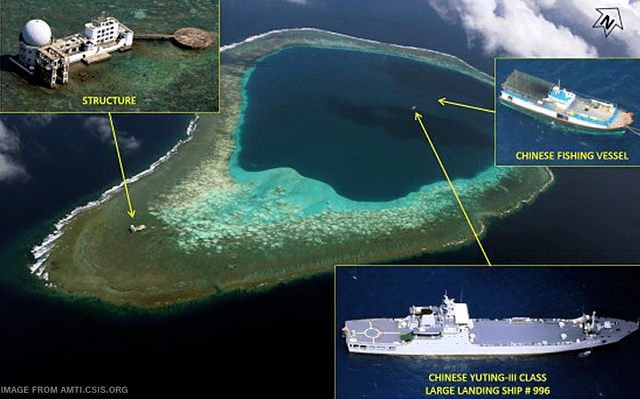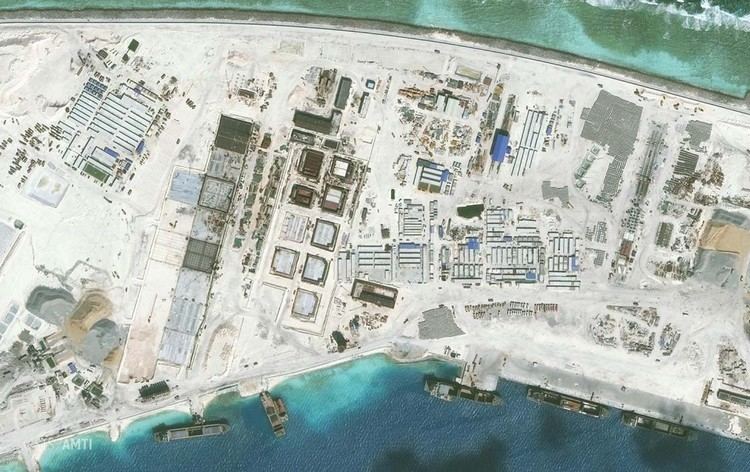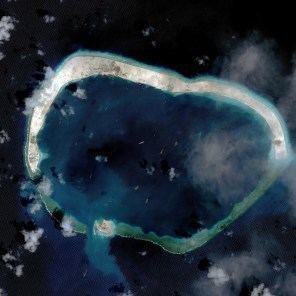 | ||
Mischief Reef (Chinese: 美济礁; pinyin: Meiji Jiao; literally: "Meiji Reef"; Tagalog: Panganiban reef; Vietnamese: Đá Vành Khăn) is a reef in the Spratly Islands in the South China Sea, located 250 kilometers (or 134.989 nautical miles) west of Palawan Island of the Philippines.
Contents

Mischief Reef has been occupied and controlled by the People's Republic of China since 1995, and is claimed by the Republic of China (Taiwan), the Philippines and Vietnam. An artificial island was made on the reef by the Chinese government from 2014 and was completed in 2016. The reef was also the subject of a 2016 tribunal ruling by the International Court of Arbitration, Hague.

The area surrounding it is said to be rich in yet unexplored oil and gas fields.
History and Etymology

One source says that Mischief reef was discovered by Henry Spratly in 1791 and was named after the German sailor Heribert Mischief, one of his crew.. Other sources suggest that the reef may have been named after the clipper Mischief that sailed regularly in the South China sea in the 1850s.
Location and Description

Mischief reef is located at 9° 55' N, 115° 32' E. It lies 50 nautical miles east of Union banks. Mischief reef consists of a lagoon and rocks that lie above water at low tide.
Territorial disputes
In 1994 and 1995, China built initial structures on stilts in the area. The Philippine government protested these actions. However, the Chinese government rejected the protest and said that the structures were shelter for fishermen. In 1999, another wave of protests from Manila occurred when China added more structures to Mischief Reef.
China was also reported to have planted buoys in nearby Sabina Shoal. Philippines claimed that China had a well-rehearsed routine when laying claim to a new reef: first put down buoys, then build concrete markers. Temporary wooden or bamboo shelters followed, and then permanent structures went up. The Philippines therefore would try to destroy the buoys or markers before China has time to build larger structures. The Philippines' decision not to destroy the Chinese structures on Mischief Reef has prevented an escalation of the dispute. The Philippines claims that China has always been prepared for armed conflict when challenged, as is evident in China's defense of reefs from Vietnam in the 1988 Johnson South Reef Skirmish which resulted in more than 70 Vietnamese deaths.
On 11 July 2012, the Chinese Type 053 frigate Dongguan ran aground on the reef, sparking embarrassment for the Chinese government and causing an awkward diplomatic situation. The ship was later towed back to base.
On 12 July 2016, the tribunal of the Permanent Court of Arbitration concluded that Mischief Reef is, or in their natural condition was, exposed at low tide and submerged at high tide and are, accordingly low-tide elevations that do not generate entitlement to a territorial sea, exclusive economic zone or continental shelf. The tribunal concluded that Mischief Reef forms part of the exclusive economic zone and continental shelf of the Philippines.
Military development
In 2015, land reclamation started inside the rims. The Philippines filed a diplomatic protest against China after the discovery of their reclamation activities. By January 2016, work was well advanced on developing a military base with a large harbour and a 2.6 kilometres (1.6 mi) runway, with the reclaimed land covering 5.58 square kilometres (2.15 sq mi). A civilian test flight to the runway was conducted by a China Southern Airlines passenger jet on 13 July 2016.
In late 2016, photographs emerged which suggested that Mischief Reef was armed with anti-aircraft weapons and a CIWS missile-defence system.
